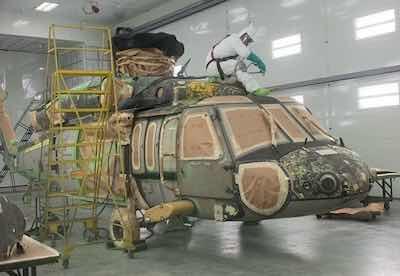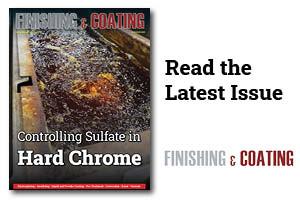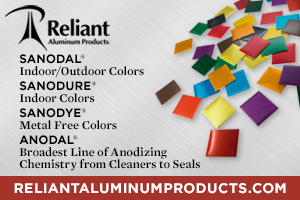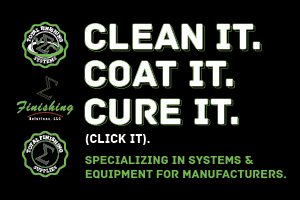In the expansive hangars of Corpus Christi Army Depot, the process lines of Letterkenny Army Depot, and multiple field-maintenance locations, the U.S. Army is rewriting the rules of aviation and missile maintenance.
 Mark Feathers, Scott Howison, Jasmine Briant, and Ted Ventresca.The familiar brown conversion coatings — long associated with aircraft like the AH-64 Apache and UH-60 Black Hawk — are being phased out. This strategic shift is more than cosmetic. It’s part of a broader initiative led by the U.S. Army Aviation and Missile Command (AMCOM) Heavy Metals Working Group to eliminate hexavalent chromium (Cr6+), a known carcinogen, and transition to safer alternatives across Army aviation platforms.
Mark Feathers, Scott Howison, Jasmine Briant, and Ted Ventresca.The familiar brown conversion coatings — long associated with aircraft like the AH-64 Apache and UH-60 Black Hawk — are being phased out. This strategic shift is more than cosmetic. It’s part of a broader initiative led by the U.S. Army Aviation and Missile Command (AMCOM) Heavy Metals Working Group to eliminate hexavalent chromium (Cr6+), a known carcinogen, and transition to safer alternatives across Army aviation platforms.
The efforts of AMCOM’s Heavy Metals Working Group involve years of testing alternatives to existing hex-chrome materials. Recently, a newly patented next-generation solution called eTCP came to the attention of AMCOM and is under review by the Heavy Metals Working Group. To trace the path of how an innovation like eTCP is validated as a solution to replace a legacy military workhorse like hex chrome, you need to look back nearly 100 years.
A Corrosion Fighter with Consequences
Beginning with the initial testing of chromates for corrosion protection in the 1930s, the full integration of hexavalent chrome into military applications likely started as early as 1941, when wartime production ramped up, and the need for effective corrosion protection became critical for maintaining equipment in harsh environments. Cr6+ has been the Army’s standard corrosion inhibitor. Integrated into paints, primers, conversion coatings, and sealants, hexavalent chromium offered unmatched protection in extreme environments — from salt-laden coastal air to abrasive desert dust.
“Army researchers continue to develop and test viable coatings, adhesives, and sealants alternatives that will ultimately be approved for use on Army weapons systems.”
These materials enabled legacy aircraft, weapons, and vehicles to remain operational far beyond their original service lives. But this durability has come at a significant cost. Cr6+ is a toxic heavy metal that poses severe risks to personnel and the environment. Recognizing this, the Department of Defense issued Directive 5000.01 to minimize environmental and occupational hazards. Army Acquisition Policy followed, explicitly targeting Cr6+for elimination in production, maintenance, and sustainment activities.
The Challenge of Legacy Specifications
Transitioning away from Cr6+ is not as simple as swapping one material for another. Many military platforms remain tethered to outdated technical data packages (TDPs) and specifications requiring Type I hexavalent chrome coatings under MIL-DTL-81706. Unless updated by OEMs or the Department of Defense (DoD), these requirements remain binding for depots, field repair stations, and Maintenance, Repair, and Overhaul (MRO) contractors.
Even where alternatives exist, few match Cr6+ one-for-one in performance — particularly in corrosion resistance, adhesion, and long-term durability. This has made the transition both technically and administratively complex. Additionally, a significant amount of testing is required to ensure performance requirements are not compromised with the non-Cr6+ alternative.
“Army researchers continue to develop and test viable coatings, adhesives, and sealants alternatives that will ultimately be approved for use on Army weapons systems. As we progress, our processes and materials will change, and the requirement for personal protective equipment will diminish as we incorporate our advancements into our current and future facilities,” Feathers says in a 2020 AMCOM www.FinishingAndCoating.com article at https://finishingandcoating.com/index.php/liquid-coat/213-u-s-army-reducing-heavy-metal-exposure-in-military-paints
“It was recognized early that protection of our people and sustainability of our maintenance processes required the elimination of hexavalent chromium.”
The financial burden is also significant. The Army invested $3 million at Corpus Christi Army Depot in mitigation systems, including HEPA filtration and vacuum units. At Fort Drum, a single hangar decontamination project cost $250,000. These investments aim to reduce exposure, but the root issue remains: Cr6+ is still widely used. Personnel working with hex chrome face elevated risks of respiratory illness and cancer, monitored through ongoing medical surveillance programs.
A 60+ Member Coalition Leading the Charge
 To address this challenge, AMCOM formed the Heavy Metals Working Group — a coalition of over 60 subject-matter experts from across the Army’s engineering, environmental, and logistics directorates. Led by figures such as Mark Feathers, AMCOM G-4 Lead Project Manager, and Scott Howison, AMCOM Physical Scientist, the group has spearheaded the Army’s Cr6+ elimination effort.
To address this challenge, AMCOM formed the Heavy Metals Working Group — a coalition of over 60 subject-matter experts from across the Army’s engineering, environmental, and logistics directorates. Led by figures such as Mark Feathers, AMCOM G-4 Lead Project Manager, and Scott Howison, AMCOM Physical Scientist, the group has spearheaded the Army’s Cr6+ elimination effort.
Their dual mission is to protect personnel and sustain mission readiness.
“It was recognized early that protection of our people and sustainability of our maintenance processes required the elimination of hexavalent chromium,” Feathers says. “This led to our efforts to develop 15 different processes for both depot and field maintenance operations to mitigate the impacts of hexavalent chromium.”
By the end of 2019, the group had mapped every AMCOM site with known exposure risks — not only from Cr6+ but also cadmium, lead, and beryllium — and prioritized strategies to develop alternatives based on exposure risk and mission impact.
“Aluminum conversion coatings, being very pervasive in our processes, became a very high priority for replacement since the risk exists while applying and removing this coating,” Feathers says.
Partnerships Driving Change
AMCOM’s Heavy Metals Working Group doesn’t work in isolation. It collaborates closely with the Combat Capabilities Development Command Aviation and Missile Center and the Army Research Laboratory to test, validate, and transition viable alternatives into production. It also collaborates closely with partners at NAVAIR and the Air Force to share technological developments for the mutual benefit of the DoD industrial base.
The Army Contracting Command and resource managers help align funding and update contractual requirements, while technical leaders ensure that validated materials are qualified under relevant Military Specifications (MIL Specs).
One such material class is Type II trivalent chromium conversion coatings — CrVI -free alternatives approved under MIL-DTL-81706B and MIL-DTL-5541F for brush/wipe, spray, immersion, and touch-up applications. These coatings are listed on the Qualified Products Database (QPD) and represent a new generation of solutions offering comparable corrosion resistance without the toxic burden of Cr6+.
Among these, eTCP — a patented Type II trivalent chromium product — provides a distinct violet color indicator, allowing visual verification that a part is coated. This color serves as a subtle nod to the legacy brown of hex chrome while signaling a safer path forward.
“The diligence of AMCOM’s Heavy Metal Working Group to identify, test, and validate solutions like our chemistry ensure the Army’s aviation fleet remains ready to protect on air, land, and sea with a safer environmental solution that also protects the coatings applicators at the OEM, shop, field repair and front line.”
“We recognized that a technological advance in the chemistry of conversion coatings of aluminum had occurred under a Navy NESDI project, and the result was the development of eTCP,” Howison says. “It only made sense to partner with our Navy colleagues for a cross-service solution that could provide benefits to sustainability and readiness across the defense industrial base.”
The Army communicates validated materials, such as eTCP, to the broader maintenance and repair community through depot and field maintenance documentation, including Aviation Maintenance Action Messages (AMAMs). These channels ensure that depots, field repair teams, original equipment manufacturers (OEMs), and coating facilities receive timely updates and implementation guidance.
“Many factors are carefully considered in the rollout of a new technology like eTCP for use by artisans and field maintainers,” Howison says. “Our objective is to ensure the smoothest implementation possible by provisioning the supply chain to handle increased demand, training the workforce, and then providing ongoing support to maintainers and warfighters as they begin to use the new technology to protect our assets.”
Shedding a Chemical Legacy
As Type II conversion coatings are implemented at depots and field repair stations, the Army is not merely replacing a material — it is retiring a chemical legacy. This marks a turning point, proving that innovation in materials science can safeguard both mission readiness and human health.
“The diligence of AMCOM’s Heavy Metal Working Group to identify, test, and validate solutions like our chemistry ensure the Army’s aviation fleet remains ready to protect on air, land, and sea with a safer environmental solution that also protects the coatings applicators at the OEM, shop, field repair and front line,” says Ted Ventresca, President and Chief Operating Officer of CHEMEON Surface technology. eTCP is now available globally through the Defense Logistics Agency (DLA).
Mark G. Feathers is the Environmental Engineer Lead, and Scott Howison and Jasmine Briant are Physical Scientists for the United States Army Aviation and Missile Command (AMCOM)-G4. Ted Ventresca is the President of Chemeon Surface Technology. Visit https://www.amcom.army.mil and https://chemeon.com.



































